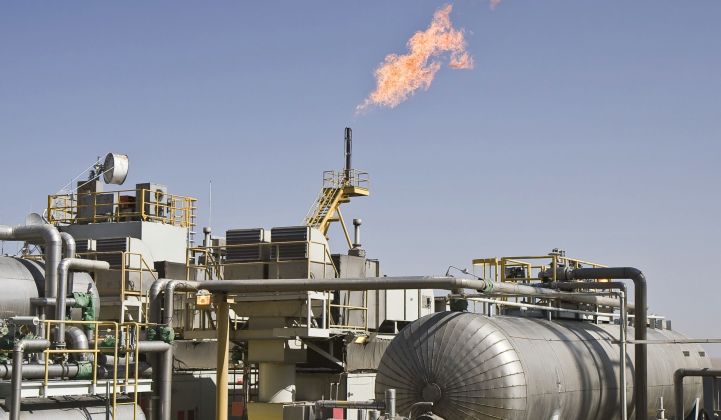It looks like natural gas is the new green for General Electric’s Ecomagination initiative.
On Monday, GE announced it was putting $10 billion more into its green energy R&D program, with a focus on greening an industry that’s gotten a bad rap among environmental advocates. That’s the natural gas industry, and in particular, the much-maligned method of getting gas out of the ground through hydraulic fracturing, or fracking.
The new commitment, announced by GE CEO Jeffrey Immelt, will bring total investment in the nearly decade-old initiative to $25 billion by 2020. Since its start in 2005, GE has invested $12 billion into Ecomagination, and is on track to meet its $15 billion commitment by next year, he announced.
Sales of Ecomagination-branded GE product lines have since outpaced those from other business units at the industrial giant, generating $160 billion in revenue since the program’s inception, according to Monday’s announcement. That’s up from $85 billion in revenue reported in 2011, and includes products ranging from higher-efficiency wind turbines and battery-assisted locomotives to more efficient jet engines and natural-gas-fired turbines.
But if Monday’s announcement can be taken as a guide, GE is doubling down on natural gas as its green focus for the coming years. Out of the three research areas being targeted for the new $10 billion investment, only one -- reducing the cost and increasing the output of GE’s wind turbines -- is focused on renewable energy.
The other two are squarely focused on natural gas, including a push to improve power plant efficiencies, and two new R&D partnerships with natural gas companies aimed at reducing waste and resource use in gas extraction.
The first R&D project with Norwegian energy company Statoil is aimed at evaluating the feasibility of replacing the water that’s injected into deep underground rock formations in the fracking process with a substance the world really wants to see buried: carbon dioxide.
“While the use of CO2 to fracture shale rock formations occurs today, it is not an economically viable option for large-scale use due to its high costs,” GE announced. The new project will “evaluate whether a system can be designed to capture CO2 produced from emissions; reuse the CO2 to fracture rock formations; and then capture it again for re-use on the next well.”
Capturing and re-injecting CO2 into oil and gas wells isn’t a new thing -- it’s one of several “enhanced oil recovery” methods in use today, and in fact has been blamed for some small-scale earthquakes in oil-well-pocketed parts of Texas. But it’s mainly limited to shallower wells, and presents some technical challenges in how it’s blended with different gases and small amounts of water for use in deep rock formations.
Nor is GE’s new proposal a route to “carbon sequestration,” or storing CO2 emissions underground, since it’s reusing captured carbon, not burying it. At the same time, it would appear to reduce the release of CO2 into the atmosphere, with the added bonus of gathering it at the same place it’s being used.
The second R&D project is aimed at capturing the natural gas that’s “flared,” or burned off, at oil and gas wells around the world, and expands on an existing relationship with Canada’s Ferus Natural Gas Fuels around turning that otherwise wasted gas into fuels that can be brought to market in cost-effective ways.
Specifically, the project will seek to extract liquids like propane and butane from that flare gas, then use GE’s “CNG In A Box” system to turn the rest into compressed natural gas (CNG). Ferus will transport that CNG in trailers to power operations at sites like remote oil and gas wells -- another example of recycling resources now being wasted or obtained from existing channels in the gas extraction process.
It seems doubtful that these kinds of fossil-fuel-fixated research projects will appear particularly eco-imaginative in the eyes of solar and wind power advocates. Nor would it appear that environmental groups opposed to fracking on broader principles of its impact on climate change will support efforts to make it more cost-effective or less water-hungry.
Even so, there’s no doubt that natural gas is going to be a part of the global energy mix for the foreseeable future, which means that we will need to see improvements on how well the industry can conserve resources, prevent environmental damage and reduce climate change impacts.
And while there are reasons to be skeptical about assurances that fracking, “tight” gas extraction and other new natural gas resources will help make the United States energy-independent in the coming decades, it would appear that GE is one of many big energy players that are betting on it playing an increasingly important role in years to come.



